NELSON Worldwide installed colorful pipes throughout the Corix space to serve a dual purpose: vibrant décor and creative wayfinding.
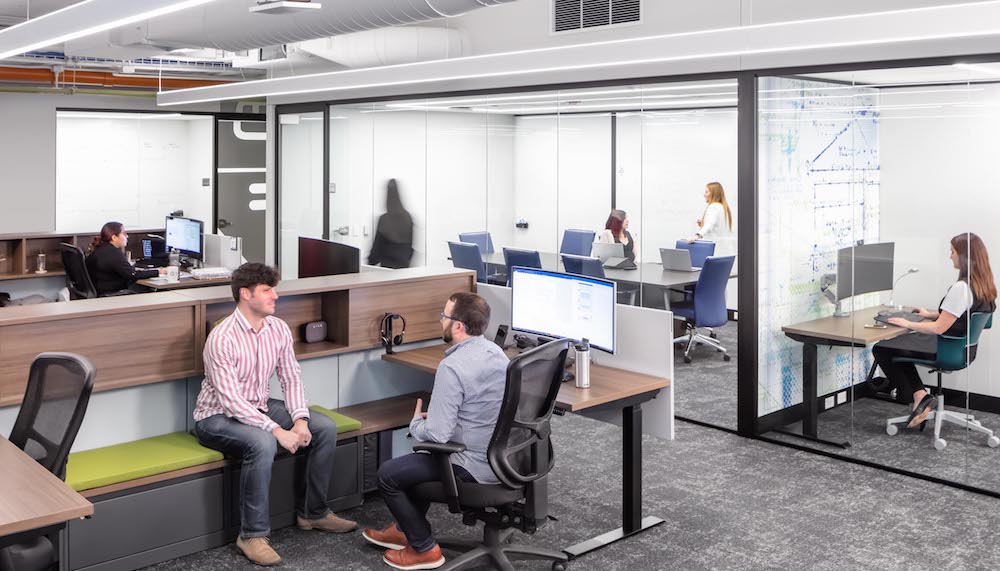
Corix tasked NELSON Worldwide with renovating their new corporate headquarters in downtown Chicago, Illinois. The company, dedicated to the implementation of sustainable water, wastewater, and energy utility infrastructure solutions, was relocating from their suburban headquarters to the new downtown Chicago location to improve the recruitment and retention of employees.
NELSON transformed their new offices to create an entirely different atmosphere from their previous space. Corix’s original offices were compartmentalized with minimal opportunities for collaboration. In contrast, the new space utilizes fewer private offices creating a more transparent environment, while functional furniture and moveable walls create natural partitions while still offering opportunities for collaboration.
Pops of color allude to the brand palette, while the overall personality of the space represents key characteristics of the company including pride, community, and collaboration. The design team also created a café for employee engagement during traditional work hours as well after-hours socializing and flexible event space, extending the utilization beyond the traditional nine to five.

Living walls throughout the office bring the outdoors in, while natural light is enhanced by open sight lines from one end of the office to the other. Taking an abstract approach to environmental graphics, NELSON installed pipes throughout the space to serve a dual purpose: vibrant décor and creative wayfinding. Each pipe color represents a core market the company serves and acts as a gentle and organic guide, leading employees and guests in the right direction.
The office is organized into “ecosystems” which adapt to support their own functions and then circulate out to the environment at large. Each ecosystem contributes to and draws from the same reservoir creating a strong chain of community. There are three distinct graphics throughout the space, each representing each of the brand’s dedicated functions – water, wastewater, and energy.
The overall design incorporates collaboration, socialization, and purpose to help celebrate the characteristics of the brand and its aspirations to grow and evolve as a company.
When was the project completed?
August 2019

How many employees work here?
70
Describe the work space type.
The space is open plan.
What kind of meeting spaces are provided?
Varying sizes and types spread throughout the floor plate to allow easy access to all teammates throughout their day.
What is the projects location and proximity to public transportation and/or other amenities?
Two blocks north of Chicago Union Station.
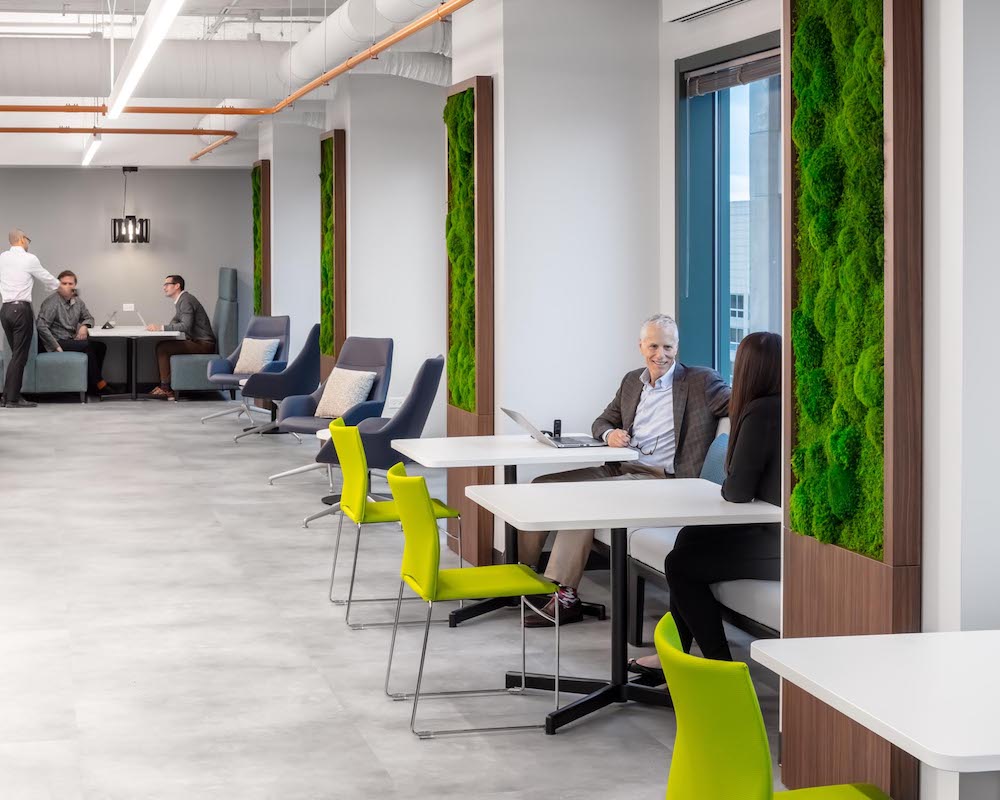
How is the space changing/adapting as a result of the COVID-19 pandemic?
This project was originally designed with flexibility in mind. We utilized demountable wall systems for portions of the architecture to allow for greater ability to make cost-effective adjustments over the length of their lease. We also designed the workstations as 6’x6’ typicals so there is adequate spacing between employees.
Any other information or project metrics?
28,000 total square feet
What kind of programming or visioning activities were used to create the space?
At the front end of this project, Colliers completed surveying, imaging exercises, visioning exercises, interviews and observation of existing space. These processes, overlaid with the design visioning process, gave the NELSON team great insight into what Corix was looking for in their new space.
Were any pre-planning surveys conducted to get employee input?
Yes, these were conducted both during Collier’s workplace strategy as well as visioning.
Were there any other kinds of employee engagement activities?
Corix created a larger internal team that was part of each design presentation and represented a great cross-section of their office. Corix also encouraged employees to visit the construction site throughout the process to get familiar with the commute, the area and to gain excitement about the project as the space came together.
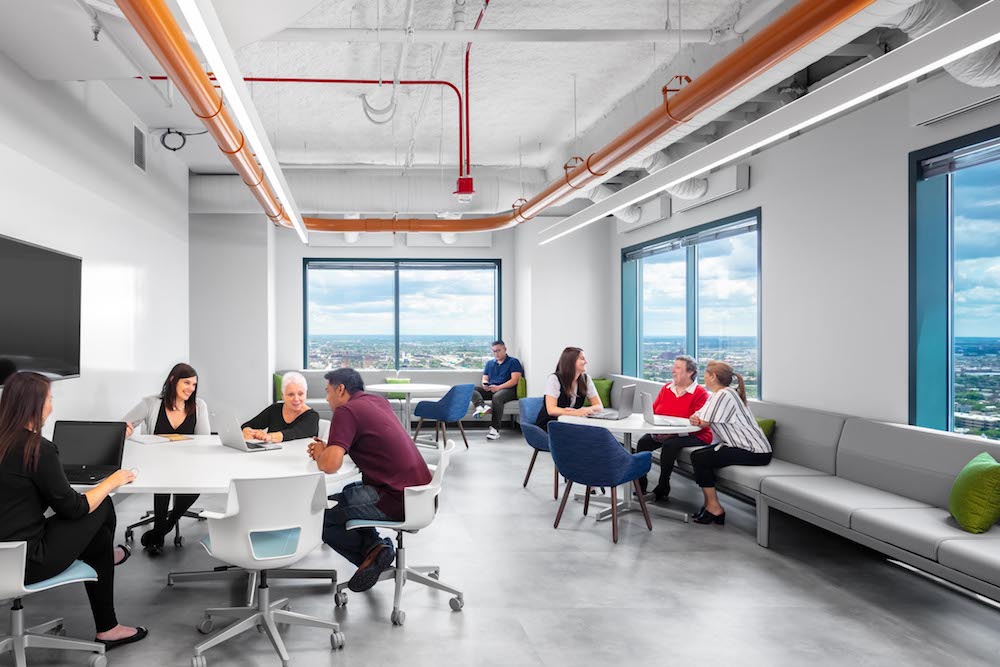
Were there any special or unusual construction materials or techniques employed in the project?
Telling the Corix story was a really important element of this design, both to employees as well as to visitors of the space. With a tight budget, we knew we had to be creative as to how we could most effectively tell this story. The story began in how the space was planned into three ecosystems that represent their main lines of business (energy, gas, and water) each of those ecosystems was branded with one of Corix’s three key brand colors. In addition, NELSON designed large super graphics to represent meters for each of these ecosystems to help liven up corridors. We also used standard line light fixtures but mounted them in ways to create graphic representations of each ecosystem as you approach it.
Most importantly, a series of colored pipes was run through the ceilings. Each ecosystem was circled by its associated colored pipe. Those individual ecosystem pipes met together at the elevator lobby at the main Corix super graphic in the ceiling to represent how each employee at Corix is contributing to the greater success of Corix as a whole. At that same point in the ceiling, larger orange pipes come in to indicate the community that Corix serves and those orange pipes run throughout the entire space to guide you to all of the common pathways and community spaces. They not only tell the story but serve as a wayfinding tool. We also worked with Corix to get copies of blueprints of their old space and created custom branded wallcovering for their phone rooms to give a nod to where they came from.
What products or service solutions are making the biggest impact in your space?
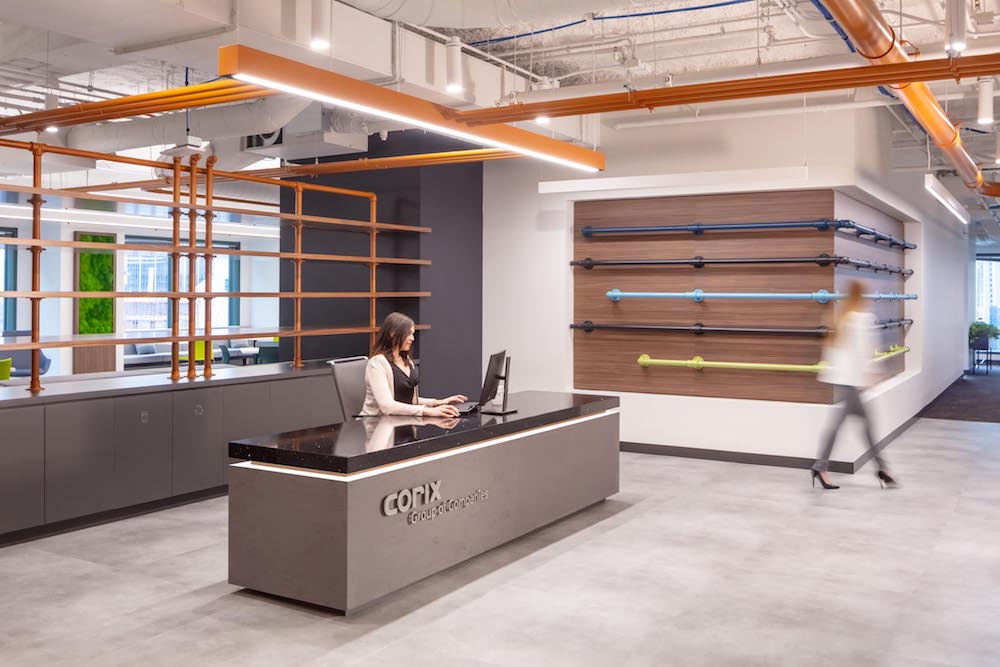
What kind of branding elements were incorporated into the design?
Within the new office, our team wanted to take a unique approach to the graphics. To do so, we drew inspiration for the company’s mission, as a leading provider of sustainable water, wastewater, and district energy solutions, the brand develops, constructs and maintains utility infrastructure. We decided to use pipes throughout the space to not only serve as vibrant décor but as a tool for creative wayfinding.
Each pipe color, whether blue, green or orange, represents a core market the company serves which acts as a gentle and organic guide, leading employees and guests in the right direction while navigating the space. We also helped organize the office into “ecosystems” which adapt to support their own functions and circulate out to the environment at large. Each ecosystem contributes to and draws from the same reservoir to create a strong chain of community.
What is the most unique feature of the space?
The pipes mentioned above throughout the space that serve as vibrant décor and a wayfinding tool.
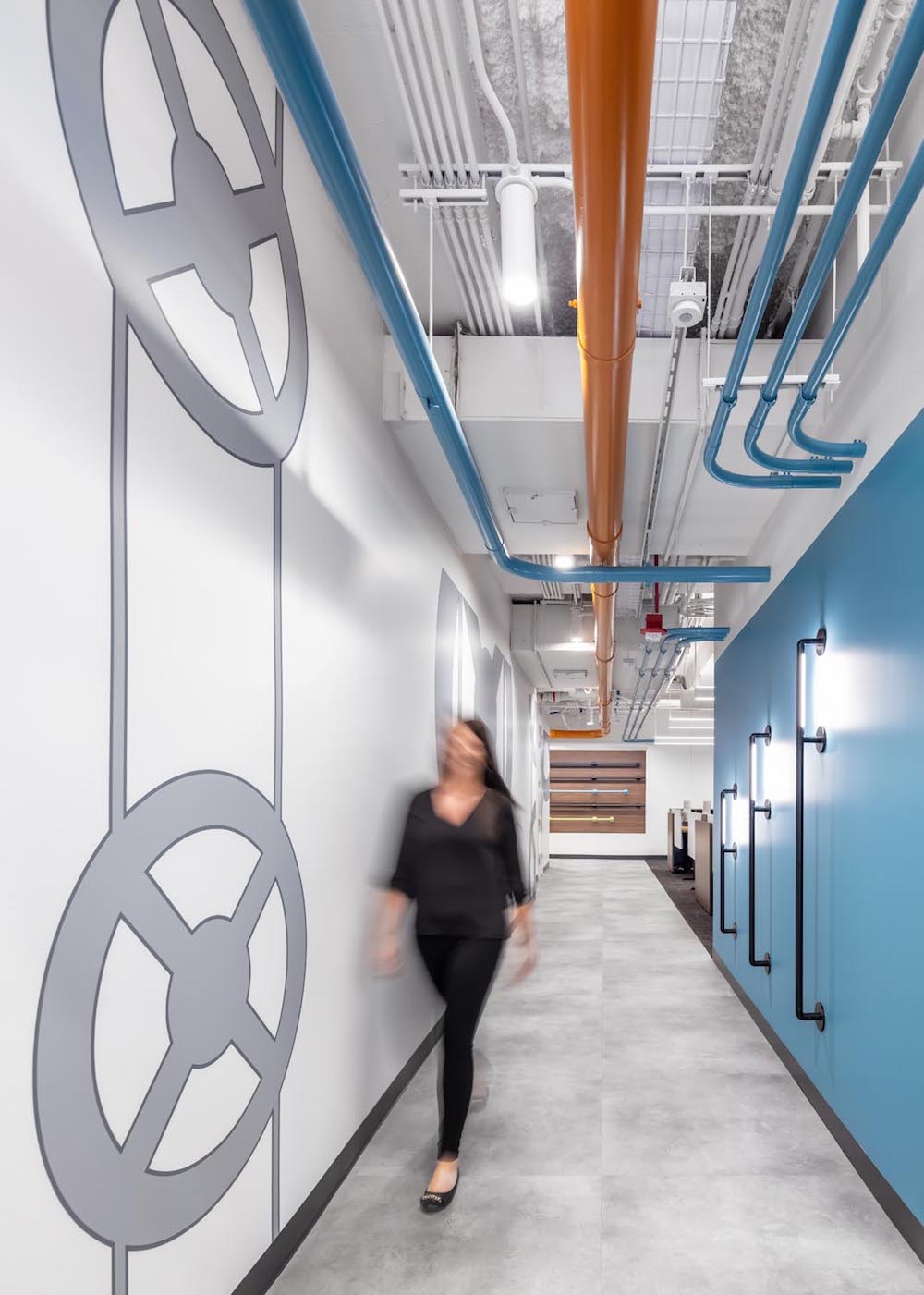
Are there any furnishings or spaces specifically included to promote wellness/wellbeing?
The 22,292-square-foot workplace features moss walls throughout the public spaces and planters along all main corridors, while natural light is enhanced by open sight lines from one end of the office to the other.
If the company relocated to a new space, what was the most difficult aspect of the change for the employees?
The biggest concern was moving downtown from the suburbs. Corix feared that by extending the staff’s commute some would decide to leave. With the number of private offices decreasing to five, another concern was an increase in acoustics and a decrease in privacy.
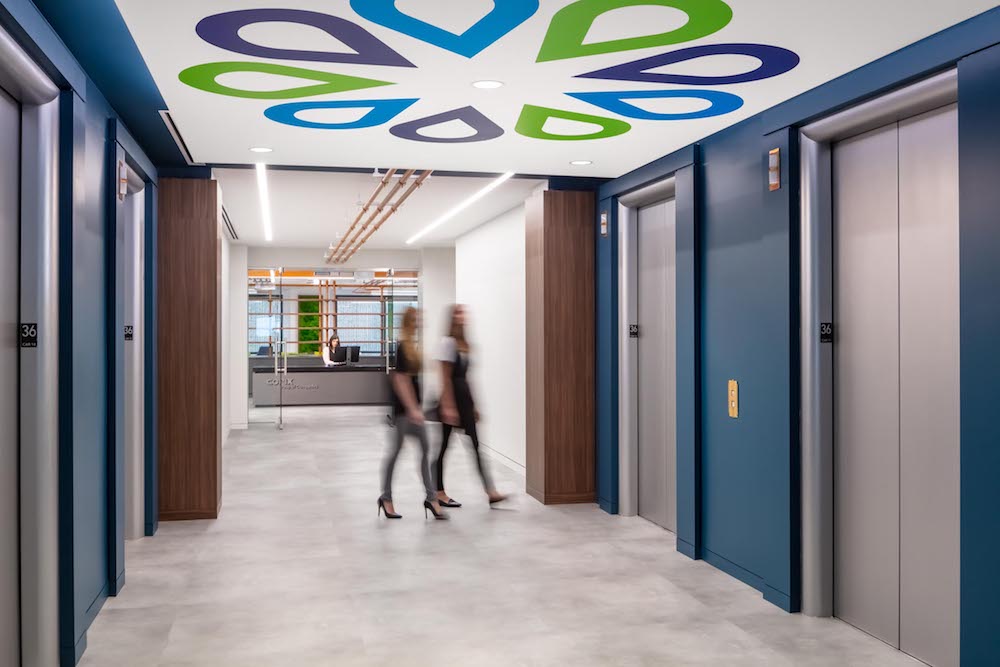
If so, what were the most surprising or illuminating or hoped-for results?
The main feedback we received post-occupancy was that the client wished that they hadn’t built any private offices at all. After experiencing the workspace those with offices felt like they were missing out on the interaction in the space.
Who else contributed significantly to this project?
- GC – Skender Construction
- Engineer – ESD Global
- Furniture Dealer – Forward Space
- Furniture Manufacturer – Steelcase
- PM/Workplace Strategy – Colliers

